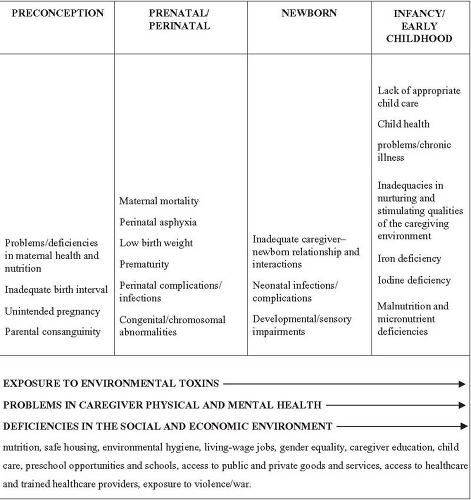Early Childhood Development in Lowand Middle-Income Countries
Ilgi Ozturk Ertem
I. Description of the problem.
A. The importance of early childhood development (ECD) and developmental risks or difficulties that begin during early childhood are increasingly recognized as important contributors to childhood morbidity in low- and middle-income (LAMI) countries. Although prevention of childhood mortality remains the focus in such countries, many countries are looking to promote ECD via healthcare delivery systems. Universal principles for the promotion of ECD in LAMI countries are multidimensional:
Optimal development is the basic right of the child. All but two countries have ratified the United Nations Convention of the Rights of the Child. The convention has brought increased awareness around the globe that regardless of place of residence, an environment that promotes his/her full developmental potential is a basic right of the child.
Development during early childhood has economic implications for nations. Research on cost-benefit analyses has emphasized that return for investment per human capital is highest during early childhood compared with any other period in the life cycle.
Research has made it possible to better understand the links between physical health and psychosocial development. The biomedical model that has dominated the approach to healthcare delivery in LAMI countries has limited attention to psychosocial and developmental issues. Recent research emphasizes that causes of poor health (e.g., malnutrition) also affect child development and that causes of poor development (e.g., unresponsive caring environments) also have an impact on health. The Lancet series entitled “Child Development in Developing Countries” has drawn attention to the need for the promotion of ECD in LAMI countries. International organizations such as the World Health Organization (WHO) and the United Nations Children’s Fund (UNICEF) have shown increased appreciation that when healthcare delivery includes a developmental context, there are beneficial effects on survival, physical health, and development.
Healthcare systems are often the only existing infrastructures reaching young children. Research in Western countries has shown that professionals can support child development during pediatric healthcare encounters. Healthcare encounters are often the only opportunity available for professionals in LAMI countries to positively influence caregivers of young children.
B. Risks to ECD are multiple in LAMI countries. Figure 18-1 describes a life cycle approach to developmental risk factors in LAMI countries, broken out further below.
Little information on child development may reach families. Young children may not be regarded as receptive to interaction and may not be given opportunities for exploration and play. Gender inequalities may place women at higher risk for difficulties in caring for themselves and in providing developmentally appropriate care to their young children.
Maternal depression in LAMI countries is at least as prevalent and has all the consequences that are present for children and families in Western cultures. Furthermore, recent research has shown that in LAMI countries, young children of depressed mothers have higher rates of low-birth weight and life-threatening disease such as diarrhea and other infections compared with children of mothers who are not depressed.
Because of displacement in war zones or moves into urban life, the support of extended family may be lost. As women increasingly join the work force without appropriate childcare facilities, they may need to leave their young children in the care of other children or alone in homes and shelters.
Far fewer encounters with healthcare providers take place in LAMI countries, and these are typically not for routine healthcare maintenance but during acute illness.
Healthcare professionals may not be equipped with information on developmental or psychosocial issues. Mental health professionals may not exist or are very
few in number and multidisciplinary teams typically may not exist. Existing professionals and healthcare systems may view support to the development of young children as a luxury that is not relevant to healthcare.
C. Strengths and protective factors that foster resilience during early childhood in LAMI countries. Risks, strengths, and resilience coexist even in the most deprived populations. As risks to optimal development differ within populations, reasons for resilience may also differ.
The primary role of the mother in caring for her young child, the slow pace of daily life, the presence of fathers and extended family, and the “whole village” that circle and nurture the child may be important protective factors for a young child’s development.
Stay updated, free articles. Join our Telegram channel

Full access? Get Clinical Tree



